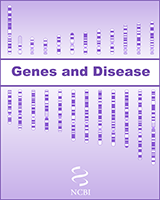NCBI Bookshelf. A service of the National Library of Medicine, National Institutes of Health.
National Center for Biotechnology Information (US). Genes and Disease [Internet]. Bethesda (MD): National Center for Biotechnology Information (US); 1998-.

In the US, lung cancer is the most common cause of cancer deaths among both men and women. In fact, North Americans have the highest rates of lung cancer in the world. In 1997, some 178,100 new cases were diagnosed, and roughly 160,400 deaths occurred from the disease. Sadly, the 5-year survival rate for persons with lung cancer is only 14%. Since the 1940s, the increase in lung cancer mortality by gender has followed historic patterns of smoking, with a 20-year time lag. About 90% of male lung cancer deaths and 80% of female lung cancer deaths are attributable to cigarette smoking. Although smoking is by far the major risk factor for lung cancer, certain industrial substances, such as asbestos, and environmental factors can contribute.
Small cell lung carcinoma is distinctive from other kinds of lung cancer (metastases are already present at the time of discovery) and accounts for approximately 110,000 cancer diagnoses annually. A deletion of part of chromosome 3 was first observed in 1982 in small cell lung carcinoma cell lines.
As with other cancers, mutations in a variety of molecules (oncogenes and tumor-suppressor genes) that control cell growth and division are observed, and no one mutation is likely to result in cancerous growth. Basic research into the function of these molecules—how and when they play their role—should help the fight against lung, and other, cancers and give clues to find appropriate therapies.
Related diseases
- Genome view see gene locations
- Entrez Gene collection of gene-related information
- BLink related sequences in different organisms
- Research articles online full text
- Books online books section
- OMIM catalog of human genes and disorders
- CancerNet from the National Cancer Institute, NIH
- American Cancer Society research and patient support
- Oncolink comprehensive cancer information from the University of Pennsylvania
- GeneLocus Links
- Lung carcinoma, small cell - Genes and DiseaseLung carcinoma, small cell - Genes and Disease
- PREDICTED: Xenopus laevis cell division cycle 42 L homeolog (cdc42.L), transcrip...PREDICTED: Xenopus laevis cell division cycle 42 L homeolog (cdc42.L), transcript variant X3, mRNAgi|2038245915|ref|XM_018224258.2|Nucleotide
- PREDICTED: Xenopus laevis cell division cycle 42 L homeolog (cdc42.L), transcrip...PREDICTED: Xenopus laevis cell division cycle 42 L homeolog (cdc42.L), transcript variant X4, mRNAgi|2038245918|ref|XM_018224256.2|Nucleotide
- PREDICTED: Canis lupus dingo cullin 1 (CUL1), transcript variant X4, mRNAPREDICTED: Canis lupus dingo cullin 1 (CUL1), transcript variant X4, mRNAgi|2272573200|ref|XM_025434024.3|Nucleotide
Your browsing activity is empty.
Activity recording is turned off.
See more...
